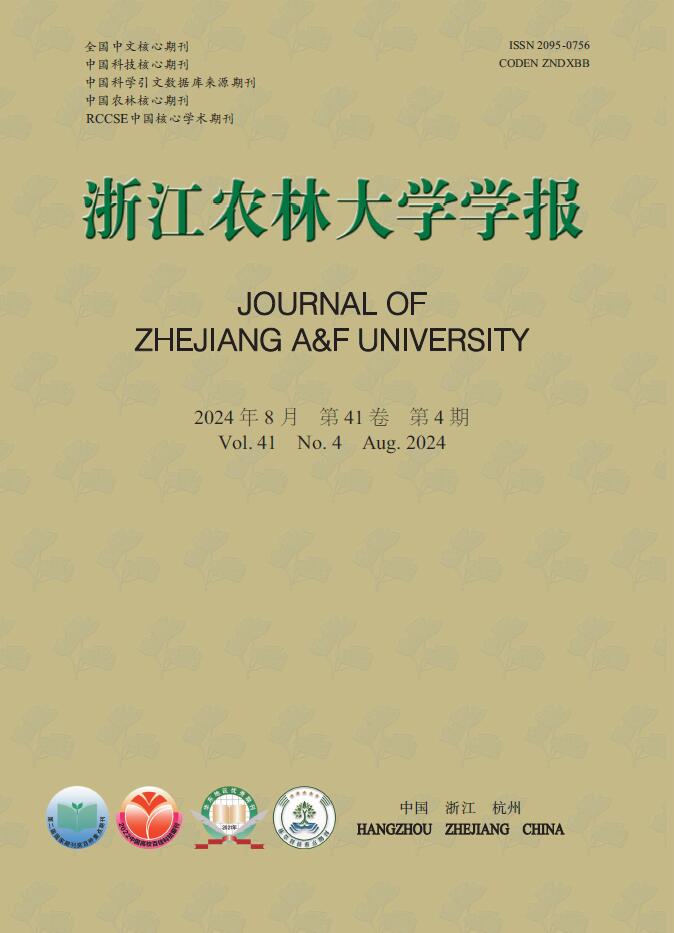-
杂草稻Oryza sativa f. spontanea是一种伴生性的稻田恶性杂草,与栽培稻O. sativa 同属禾本科Poaceae稻属Oryza[1]。目前,杂草稻已广泛分布于全球50多个国家,几乎全世界所有稻作区都有杂草稻的发生,由于其和栽培稻竞争营养、水、光照以及其他资源,严重威胁粮食安全[2]。杂草稻在生长早期,其形态与栽培稻相似,且较栽培稻开花早、光合作用强、籽粒灌浆快,还兼有种子落粒性强、休眠期短等特点,导致杂草稻不但竞争力强于栽培稻,还可以在稻田内长期续存,极难防治[3−5]。
利用简单重复序列、限制性片段长度多态性和全基因组序列对杂草稻的分子研究表明:全球杂草稻群体存在巨大遗传变异[6]。杂草稻长期处于野生状态,具耐冷、耐旱、耐盐碱、抗病等多种有利的性状和基因[7]。同时,杂草稻和栽培稻不存在生殖隔离,因此杂草稻也是栽培稻遗传改良的重要资源[8]。但不同区域的杂草稻对逆境胁迫的耐受能力并不一致。一般认为杂草稻较栽培稻具有更强的耐深播能力,宁厦杂草稻在播深12 cm时均能出苗,栽培稻则不出苗[9]。但李玉融等[10]研究表明:当埋土深度在4~7 cm内,江苏地区的常规栽培稻出苗率显著高于杂草稻。
近年来,随着水稻直播技术的广泛推广以及农业收割机跨地区作业大面积的普及,浙江省杂草稻危害愈发严重,最早发生和最为严重的是湖州市长兴县,2018年全县田畈发生频度达93.4%,除移栽稻田块和封闭式耕作田块未发现杂草稻外,全县其余水稻种植区域均有杂草稻发生,严重田块甚至颗粒无收[11],对农民的经济收入造成严重的影响。为遏制浙江省杂草稻的蔓延趋势,探索适宜的防控技术,本研究以浙江省湖州市长兴县杂草稻种子为材料,研究其在多种胁迫环境下的种子萌发特性,为杂草稻的防除和种质资源利用提供依据。
-
2021年秋季,选用浙江省长兴县稻田采集的杂草稻种子以及同一田块种植的栽培稻‘南粳46’‘Nangeng 46’种子为研究材料,所有种子收获后自然干燥至种子水分低于13%,置于4 ℃冷库中储藏备用。
-
将采集的杂草稻和栽培稻种子经体积分数为0.5%的次氯酸钠溶液消毒5 min后,用清水冲洗干净,均匀置于垫有3层湿润发芽纸的发芽盒(12 cm×12 cm×6 cm)中,于25 ℃恒温发芽,光照8 h/黑暗16 h,光通量为250 μmol·m−2·s−1。3次重复,各重复100粒种子。每天记录发芽种子数,第5天计算发芽势,第14天计算发芽率。整个发芽过程适时补充清水,保持发芽纸处于湿润状态。参照陈志超等[12]的方法,计算发芽指数(gi)和平均发芽时间($\bar t _{\rm{g}}$),公式为 gi=Σ(nt/td),$\bar t _{\rm{g}} $=Σ(nt×td)/Σtd。其中,nt为第t天的发芽种子数,td为发芽日数。发芽结束后,随机取幼苗10株·盒−1,分别测量根长、苗高和根苗鲜质量(根鲜质量指地下部分质量,苗鲜质量指地上部分质量),计算平均值。
-
种子处理方法同1.2.1的标准发芽试验。参考文献[13−14],采用0.15 mol·L−1NaCl溶液模拟盐胁迫条件,发芽纸用该溶液浸湿并保持湿润状态。3次重复,各重复100粒种子。发芽指标和幼苗品质统计同标准发芽试验。
-
种子处理方法同1.2.1的标准发芽试验。采用质量百分比为15%的聚乙二醇(PEG 6000)溶液模拟干旱胁迫条件,发芽纸用该溶液浸湿并保持湿润状态。3次重复,各重复100粒种子。发芽指标和幼苗品质统计同标准发芽试验。
-
种子处理方法同1.2.1的标准发芽试验。整个发芽过程保持水深5 cm[15]。3次重复,各重复100粒种子。发芽指标和幼苗品质统计同标准发芽试验。
-
种子处理方法同1.2.1的标准发芽试验。在15 ℃恒温发芽,整个发芽过程适时补充清水,保持发芽纸处于湿润状态。3次重复,各重复100粒种子。发芽指标和幼苗品质统计同标准发芽试验。
-
分别取干旱和盐胁迫下发芽试验结束后的杂草稻和栽培稻的幼苗0.15 g,加入4 mL 0.05 mol·L−1磷酸缓冲液(pH 7.8)进行研磨,在10 000 r·min−1离心15 min,取上清液用于抗氧化物酶活性和丙二醛(MDA)测定。参照WANG等[16]的方法测定MDA质量摩尔浓度。根据HU等[17]的方法,通过监测H2O2在240 nm下吸光度的降低来测定过氧化氢酶(CAT)活性。根据GUAN等[18]的方法,通过1 min内反应液在470 nm下吸光度的增加来测定过氧化物酶(POD)活性。抗坏血酸过氧化物酶(APX)和超氧化物歧化酶(SOD)活性的测定分别参照WANG等[19−20]的方法进行。
-
所得数据采用SAS进行统计分析,采用最小显著极差法(LSD)进行多重比较,显著性水平为α=0.05,百分率数据在分析前进行反正弦转换,以改善其分布的正态性,达到方差齐性的要求。
-
从表1可见:在室内标准发芽条件下,杂草稻发芽势、发芽率、发芽指数显著高于栽培稻(P<0.05),平均发芽时间显著低于栽培稻(P<0.05)。幼苗品质方面,杂草稻的平均根长显著低于栽培稻(P<0.05),平均苗长则显著高于栽培稻(P<0.05),杂草稻和栽培稻的根鲜质量和苗鲜质量无显著差异。
材料 发芽势/% 发芽率/% 平均发芽时间/d 发芽指数 根长/cm 苗长/cm 根鲜质量/(mg·株−1) 苗鲜质量/(mg·株−1) 杂草稻 78.9±3.6 a 86.2±8.1 a 3.0±0.1 b 32.2±1.0 a 6.3±0.2 b 8.3±0.5 a 17.2±1.8 a 25.3±7.2 a 栽培稻 56.0±3.4 b 63.5±1.4 b 4.4±0.2 a 19.2±1.4 b 8.6±0.2 a 5.9±0.6 b 18.3±0.9 a 21.4±7.1 a 说明:不同字母表示同一指标在不同材料间差异显著(P<0.05)。 Table 1. Seed germination and seedling quality of weedy rice and cultivated rice under standard germination conditions
-
由表2可见:在0.15 mol·L−1NaCl盐胁迫处理下,杂草稻和栽培稻种子的发芽势和平均发芽时间无显著差异,但杂草稻的发芽率和发芽指数显著高于栽培稻(P<0.05)。盐胁迫条件下萌发的杂草稻幼苗,其平均根长和苗长均显著低于栽培稻(P<0.05),根鲜质量、苗鲜质量与栽培稻无显著差异。此外,与标准发芽结果(表1)相比,盐胁迫处理后杂草稻和栽培稻种子的发芽势、发芽指数、幼苗品质(根长、苗长、根苗鲜质量)均明显下降(下降幅度在30.2%~81.4%),平均发芽时间明显延长(幅度分别为143.3%和61.4%),但杂草稻的发芽率仅下降了3.5%。
材料 发芽势/% 发芽率/% 平均发芽时间/d 发芽指数 根长/cm 苗长/cm 根鲜质量/(mg·株−1) 苗鲜质量/(mg·株−1) 杂草稻 14.7±5.7 a 83.2±3.3 a 7.3±1.2 a 15.0±0.7 a 4.4±0.9 b 2.4±0.6 b 7.3±0.1 a 9.3±0.2 a 栽培稻 24.3±3.3 a 48.3±1.4 b 7.1±0.4 a 8.6±0.6 b 6.0±1.3 a 4.0±0.7 a 8.4±0.2 a 10.1±0.2 a 说明:不同字母表示同一指标在不同材料间差异显著(P<0.05)。 Table 2. Seed germination and seedling quality of weedy rice and cultivated rice under salt stress
-
从表3可见:干旱胁迫下,杂草稻和栽培稻种子的平均发芽时间无显著差异,杂草稻的发芽势、发芽率和发芽指数均显著高于栽培稻(P<0.05)(表3)。幼苗品质方面,杂草稻的平均根长、根鲜质量和苗鲜质量均与栽培稻无显著差异,平均苗长则显著低于栽培稻(P<0.05)。与标准发芽结果(表1)相比,干旱胁迫处理后杂草稻和栽培稻种子的发芽势、发芽率、发芽指数和幼苗质量(根长、苗长、根苗鲜质量)均明显下降(下降幅度在31.4%~100.0%),平均发芽时间明显延长(幅度分别为226.7%和97.7%)。
材料 发芽势/% 发芽率/% 平均发芽时间/d 发芽指数 根长/cm 苗长/cm 根鲜质量/(mg·株−1) 苗鲜质量/(mg·株−1) 杂草稻 3.8±3.3 a 59.1±14.6 a 9.8±0.2 a 7.7±2.3 a 3.8±0.6 a 0.5±0.4 b 4.0±0.2 a 2.5±0.1 a 栽培稻 0.0±0.0 b 32.7±4.1 b 8.7±0.9 a 3.5±0.9 b 3.5±0.4 a 1.2±0.3 a 3.5±0.1 a 3.1±0.1 a 说明:不同字母表示同一指标在不同材料间差异显著(P<0.05)。 Table 3. Seed germination and seedling quality of weedy rice and cultivated rice under drought stress
-
在5 cm水深条件下,杂草稻种子的发芽势、发芽指数均显著低于栽培稻(P<0.05),发芽率、平均发芽时间与栽培稻无显著差异(表4)。与栽培稻相比,淹水胁迫显著降低了杂草稻的平均根长和苗鲜质量(P<0.05);但杂草稻的苗长和根鲜质量均与栽培稻无显著差异。与标准发芽结果(表1)相比,淹水胁迫处理后杂草稻和栽培稻种子的发芽势、发芽率、发芽指数和幼苗品质(根长、苗长、根苗鲜质量)均明显下降(下降幅度在35.6%~94.2%),平均发芽时间明显延长(幅度分别为116.7%和38.6%)。
材料 发芽势/% 发芽率/% 平均发芽时间/d 发芽指数 根长/cm 苗长/cm 根鲜质量/(mg·株−1) 苗鲜质量/(mg·株−1) 杂草稻 5.8±1.8 b 37.3±9.4 a 6.5±0.3 a 5.7±1.2 b 0.9±0.0 b 1.8±0.2 a 1.0±0.2 a 3.1±0.7 b 栽培稻 17.1±1.6 a 40.9±8.0 a 6.1±0.0 a 7.1±1.3 a 1.6±0.0 a 1.8±0.1 a 1.1±0.2 a 5.2±0.2 a 说明:不同字母表示同一指标在不同材料间差异显著(P<0.05)。 Table 4. Seed germination and seedling quality of weedy rice and cultivated rice under flooding stress
-
15 ℃低温条件下,杂草稻和栽培稻种子的发芽势均为0,其他发芽指标均无显著差异(表5)。幼苗品质方面,杂草稻的平均根长和苗长均与栽培稻无显著差异,但其根鲜质量和苗鲜质量均显著高于栽培稻(P<0.05)。此外,与标准发芽结果(表1)相比,低温胁迫处理后杂草稻和栽培稻种子的发芽势、发芽率、发芽指数和幼苗质量(根长、苗长、根苗鲜质量)均明显下降(下降幅度为63.6%~100.0%),平均发芽时间明显延长(幅度分别为323.3%和195.5%)。
材料 发芽势/% 发芽率/% 平均发芽时间/d 发芽指数 根长/cm 苗长/cm 根鲜质量/(mg·株−1) 苗鲜质量/(mg·株−1) 杂草稻 0.0±0.0 a 24.8±3.4 a 12.7±0.2 a 1.5±0.3 a 0.8±0.0 a 0.4±0.1 a 2.2±0.7 a 2.8±0.6 a 栽培稻 0.0±0.0 a 23.1±4.9 a 13.0±0.2 a 1.2±0.4 a 0.8±0.0 a 0.4±0.0 a 0.8±0.1 b 1.1±0.2 b 说明:不同字母表示同一指标在不同材料间差异显著(P<0.05)。 Table 5. Seed germination and seedling quality of weedy rice and cultivated rice under chilling stress
-
盐胁迫处理后,杂草稻幼苗的CAT、SOD、POD活性均显著高于栽培稻(P<0.05),MDA质量摩尔浓度则显著低于栽培稻(P<0.05,表6)。杂草稻和栽培稻幼苗的APX活性无显著差异。
材料 CAT/(×16.67 nkat·g−1) SOD/(×16.67 nkat·g−1) POD/(×16.67 nkat·g−1) APX/(×16.67 nkat·g−1) MDA/(nmol·g−1) 杂草稻 37.3±2.7 a 239.5±18.3 a 204.5±9.1 a 177.8±1.5 a 4.7±0.2 b 栽培稻 22.2±1.5 b 112.4±7.7 b 193.9±7.0 b 168.9±3.1 a 8.9±0.6 a 说明:不同字母表示同一指标在不同材料间差异显著(P<0.05)。 Table 6. Antioxidant enzyme activity and MDA content of weedy rice and cultivated rice seedlings under salt stress
-
干旱胁迫处理后,杂草稻和栽培稻幼苗的APX活性差异不显著(表7)。杂草稻幼苗的MDA质量摩尔浓度显著低于栽培稻(P<0.05),CAT、SOD和POD活性则显著高于栽培稻(P<0.05)。
材料 CAT/(×16.67 nkat·g−1) SOD/(×16.67 nkat·g−1) POD/(×16.67 nkat·g−1) APX/(×16.67 nkat·g−1) MDA/(nmol·g−1) 杂草稻 34.5±0.1 a 228.3±31.1 a 367.9±32.9 a 115.2±7.1 a 3.6±0.3 b 栽培稻 13.8±0.7 b 155.4±14.1 b 303.5±15.4 b 112.4±4.6 a 11.1±0.9 a 说明:不同字母表示同一指标在不同材料间差异显著(P<0.05)。 Table 7. Antioxidant enzyme activity and MDA content of weedy rice and cultivated rice seedlings under drought stress
-
杂草稻的生存环境复杂多样,且经过长期的自然选择,其遗传多样性高,对区域环境的适应性强,不但在生长特性上表现出较强的竞争优势,而且具备对多种生物、非生物逆境的耐受性[21−23]。同时,由于杂草稻和栽培稻、野生稻O. rufipogon之间存在特殊的亲缘关系,研究和利用杂草稻的优异特性正日益受到重视[24−25]。比如,通过结合传统育种和分子育种等手段,充分利用杂草稻的稻属资源,可以丰富现有栽培稻品种的遗传基础,培育具备优良特性的水稻新品种[8, 23]。
杂草稻的遗传多样性丰富,不同区域的杂草稻特征特性不一。目前,已开展了对东北稻区[26−27]、宁夏稻区[9, 28]、江苏稻区[10]、上海稻区[29]杂草稻的生长特性和耐逆性研究,但对近年来杂草稻危害频发的浙江稻区研究较少。本研究在多种非生物胁迫条件下,对浙江稻区杂草稻和同一田块栽培稻的种子萌发和幼苗生长情况研究发现:在正常环境条件下,杂草稻种子的萌发能力显著强于栽培稻,且杂草稻更耐盐和干旱胁迫,但对淹水胁迫更敏感。
标准发芽结果表明:杂草稻种子的各项发芽指标均显著优于栽培稻,说明杂草稻种子的萌发能力显著强于栽培稻,这与黄俊浩[29]的结果类似。本研究还发现:杂草稻幼苗的根长显著低于栽培稻,苗长则显著高于栽培稻。推测可能是杂草稻适应环境的一种表现:一方面保证尽量多的种子能够萌发出苗,另一方面通过快速的苗生长占据有利生态位,与栽培稻竞争光照、温度等生长所必需的资源。
与标准发芽相比,0.15 mol·L−1 NaCl盐胁迫处理后,杂草稻的发芽率下降了3.5%,但仍保持在80%以上;而‘南粳46’的发芽率则降低了23.9%,下降幅度大。这说明浙江省杂草稻种子更耐盐。李振博等[13]发现180 mmol·L−1 NaCl胁迫对杂草稻发芽势的影响明显小于常规栽培稻,在培养至108 h时,NaCl对杂草稻的抑制率为0,而对栽培稻‘Ⅱ优98’ ‘Ⅱ you 98’和‘武育粳3号’‘Wuyugeng 3’抑制率仍有25%和58%。李玉融等[10]研究发现:在不同浓度盐胁迫下,苏南和苏中地区的杂草稻种子萌发率均高于栽培稻。张丽丽等[14]研究表明:在不同盐胁迫下,杂草稻‘WR03-12’株高、生物量、根系特征降幅小于栽培稻‘越光’‘Koshihikari’和‘长白9号’‘Changbai 9’,前者通过保持较大根长、表面积和总体积,以此吸收更多的水分,适应环境,提高竞争效率。本研究盐胁迫后发现:杂草稻的根苗长度均显著低于栽培稻,苗长变化率高于栽培稻,表明不同区域的杂草稻特征特性不一。
干旱胁迫处理后杂草稻种子萌发和幼苗质量与盐胁迫类似,即杂草稻种子的发芽情况显著优于栽培稻种子,且与标准发芽结果比,杂草稻的发芽势、发芽率、根长变化率均低于栽培稻,表明浙江省杂草稻种子更耐干旱胁迫,这与李玉融等[10]和李海粟等[27]的研究结果类似。李玉融等[10]比较了不同干旱条件下江苏稻区杂草稻和栽培稻种子的萌发速率,发现杂草稻的萌发率显著强于栽培稻,推测这是旱直播条件下杂草稻发生较重的原因之一。李海粟等[27]则发现东北稻区杂草稻种子耐旱能力显著强于栽培稻。
盐胁迫、干旱胁迫等会导致植物体内活性氧(ROS)的积累,从而引发氧化损伤,并进一步引发膜不饱和脂肪酸过氧化,而过氧化的程度可通过测定MDA质量摩尔浓度来表征[19]。SOD、CAT、APX和POD等抗氧化物酶被认为是植物体内ROS的重要清除剂[20]。本研究发现:干旱胁迫和盐胁迫后杂草稻幼苗的MDA质量摩尔浓度显著低于栽培稻,SOD、CAT和POD活性则显著高于栽培稻,这与丁国华等[8, 30]的研究结果类似。以上研究发现:干旱胁迫对杂草稻种子的萌发抑制程度明显低于栽培稻,且对杂草稻根系的抑制程度比地上部更小。此外,干旱胁迫下杂草稻幼苗的抗氧化物酶活性更高,MDA质量摩尔浓度则更低,推测这可能是杂草稻适应干旱胁迫的机制之一。WANG等[31]研究了61份的杂草稻种子耐干旱萌发能力发现:杂草稻种子耐旱萌发能力显著高于与之共存的栽培稻,推测杂草稻可能进化出了新的耐旱性。
本研究发现:淹水条件下,浙江省杂草稻的种子萌发和幼苗质量均较栽培稻更差,且杂草稻的各项指标变化率均高于栽培稻,说明浙江省杂草稻对淹水胁迫敏感。曹旦等[32]研究发现:淹水2 cm水深时,杂草稻很难出苗。余柳青等[15]研究表明:深水层处理后,杂草稻‘落粒粳’‘Luoligeng’成苗率和植株高度显著下降,常规粳稻‘春江11’‘Chunjiang 11’则具有较强的耐水淹特性。
低温胁迫处理后杂草稻和栽培稻种子发芽指标间并无显著差异,但杂草稻的幼苗品质较栽培稻稍好,说明浙江省杂草稻的耐寒能力与栽培稻无显著差异,这与北方稻区[26−28]的研究结果不一致。例如邹德堂[26]研究发现:黑龙江省5种杂草稻的耐寒能力比当地的栽培稻品种‘东农416’‘Dongnong 416’更强,特别是红长芒杂草稻的发芽率显著高于其他杂草稻。李玉融等[10]则发现苏南、苏中地区杂草稻种子比当地的栽培稻更耐低温,苏北地区相反。综上所述,不同地区的杂草稻耐低温特性存在较大差异,遗传多样性较高。
-
浙江省杂草稻种子在适宜条件下的萌发能力显著强于栽培稻,且杂草稻更耐干旱和盐胁迫,但对淹水条件敏感。浙江省杂草稻的耐干旱和耐盐能力可能与其抗氧化活性更高有关。对于直播稻田,可在播种后灌水,对于移栽稻田,则可在移栽前后保持一定深度的水位,以减少杂草稻种子萌发。
Identification of seed germination ability of weedy rice under stress in Zhejiang Province
doi: 10.11833/j.issn.2095-0756.20230521
- Received Date: 2023-10-23
- Accepted Date: 2024-04-26
- Rev Recd Date: 2024-03-28
- Available Online: 2024-07-12
- Publish Date: 2024-07-12
-
Key words:
- weedy rice /
- seed germination /
- environmental stress /
- antioxidant capacity
Abstract:
| Citation: | WANG Bei, SUN Li, XIAO Ting, et al. Identification of seed germination ability of weedy rice under stress in Zhejiang Province[J]. Journal of Zhejiang A&F University, 2024, 41(4): 688-695. DOI: 10.11833/j.issn.2095-0756.20230521 |









 DownLoad:
DownLoad: